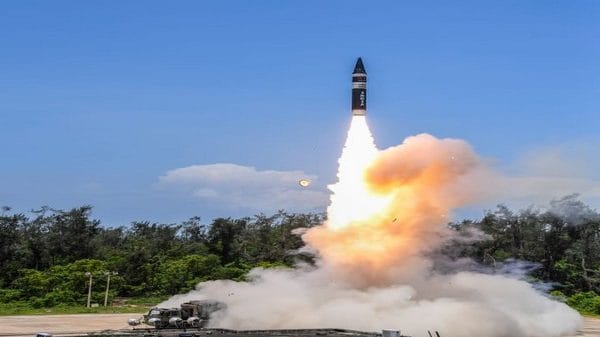Thank you dear subscribers, we are overwhelmed with your response.
Your Turn is a unique section from ThePrint featuring points of view from its subscribers. If you are a subscriber, have a point of view, please send it to us. If not, do subscribe here: https://englishdev.theprint.in/subscribe/
As the Ladakh standoff continues, if the PLA decides to wage a war of occupation, their attack will not be focused just on LAC. India’s NFU doctrine has not been cast in stone. On November 23, 2022 India last tested its AGNI-III missile, an intermediate-range ballistic missile that has a range of 3500 kms. This test was a night trial conducted by the Strategic Forces Command (SFC). It was critical to cross-check all the technical parameters as well as the readiness of the missile during night operations. With logistical support provided by DRDO, the missile test took place for the entire range. “The successful test was part of routine user training launches by the SFC. The launch was carried out for a predetermined range and validated all operational parameters of the weapon system,” the Ministry of Defense (MoD) statement said. The said AGNI-III test (November 23, 2022) was the second night test after the first night test (December 1, 2019) had failed due to stage separation.
The DRDO began developing AGNI-III in the late 1990s. In 2011, the AGNI-III got inducted in service. Apart from being solid fueled, AGNI-III is expected to have technologies like improved guidance as well as control, mission sequencing, state of the art avionics etc. It has got a very accurate navigation mechanism along with a guidance system. To reduce drag, a nose cone is mounted on a missile. This nose cone has a high ballistic coefficient. Generally, for observing reduced drag, missiles are aerodynamically designed by keeping them long and thin. So, the ballistic coefficient is defined as a measure of an object’s ability to move through air.
For example, the AGNI-III missile has a high ballistic coefficient. Therefore, along with missile frame made of carbon composites, it causes higher re-entry speed along with a lighter payload. In fact, the lighter payload also enables an increased range. The AGNI-III has two solid fueled stages. They both are made up of light weight composite material case, to observe large fuel carrying capacity, for small size and long range of this missile.
Back in 2008, the Indian scientists of IISc (Bangalore) had developed a great technology. It could have been used to increase the missile range by some forty percent. At that time, the only long-range missile India had was the Agni III with the capacity to hit targets 3,500 km away. This new innovation could have increased its range up to 4,900 km. The increase in range is viable by including the special-coating of chromium metal to the blunted nose mounted on a missile.
A missile flying at hypersonic speeds (more than five times the speed of sound) faces gigantic air drag due to friction. At such speed, the temperature can go up to 2000 degree Celsius. Experiments in lab show that drag with the help of coating can be reduced by forty seven percent. It would have resulted increase in the range by forty percent. The said innovation has got the capacity to prevent the problem of the kind that had led to disintegration of NASA space shuttle Columbia in 2003 while it was about to re-enter the atmosphere of Earth. The coating does vaporize once the missile re-enters Earth. It is an innovative method since additional energy is not needed to overcome drag. The missiles which go through outer space during their mid-course flight should not carry more fuel.
The AGNI-III has two solid fueled stages. As per Newton’s mechanics, the range of missile increases for less weight of the payload. Hence, when payload is light, the range is affected by the fuel mass-fraction of the second stage. Fuel mass-fraction is a ratio of the mass of the propellant divided by the total take-off weight of the missile. In view of this, as compared to the AGNI-II, the AGNI-III has got a higher range.
AGNI-III missile has the capacity to be fired from any geography at any point of time. As of now, it is capable of being launched from mobile railways and road mobile launcher too. The threat from China made India focused on longer range missiles successively in terms of its ballistic missile program (since AGNI-II). Thus, AGNI-III is a step further in that direction. The Indian Nuclear Doctrine (January 04, 2003) talks about the ‘No First Use’ policy. This is underpinned by a secure-second strike capability, which is not possible without AGNI-III, implicitly last point says. It is estimated that ten AGNI-III missiles can reach the entire Chinese mainland. AGNI-III as a nuclear-tipped missile is one of the important missiles for the Indian nuclear strategy. Like other missiles in the AGNI series, the AGNI-III too can be deployed in the Indian continental area, far away islands as well as its blue water naval assets.
These pieces are being published as they have been received – they have not been edited/fact-checked by ThePrint.


